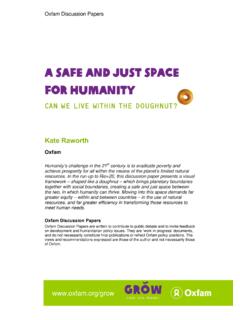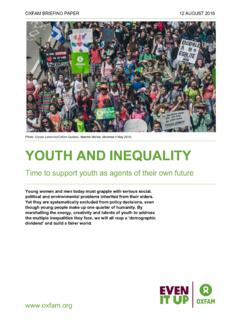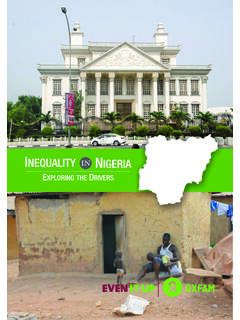Transcription of THE POWER OF EDUCATION TO FIGHT INEQUALITY - Oxfam
1 THE POWER OF EDUCATION . TO FIGHT INEQUALITY . How increasing educational equality and quality is crucial to fighting economic and gender INEQUALITY Oxfam briefing paper SEPTEMBER 2019. A good-quality public EDUCATION is liberating for individuals. It can also be an equalizer within society. This report shows the unparalleled POWER of public EDUCATION to tackle growing INEQUALITY and bring us closer together. To achieve this, EDUCATION must be both of good quality and equitable; it should be free, universal, adequately funded, with well-supported teachers, and accountable public oversight. Fairer taxation of the wealthiest can help pay for it. Oxfam International September 2019.
2 This paper was written by Jo Walker, Caroline Pearce, Kira Boe and Max Lawson. Oxfam acknowledges the assistance of Helen Bunting, Katie Malouf Bous, Anjela Taneja, Nguyen Thu Huong, Babeth Lefur, Stine Bang, Ida Kreutzman and Anthony Kamande in its production. Oxfam also wishes to thank the Oxfam EDUCATION Community of Practice and Influencing as well as the numerous country offices who have lent their support to the development of this paper . The paper is part of a series of papers written to inform public debate on development and humanitarian policy issues. For further information on the issues raised in this paper please email This publication is copyright but the text may be used free of charge for the purposes of advocacy, campaigning, EDUCATION , and research, provided that the source is acknowledged in full.
3 The copyright holder requests that all such use be registered with them for impact assessment purposes. For copying in any other circumstances, or for re-use in other publications, or for translation or adaptation, permission must be secured and a fee may be charged. Email The information in this publication is correct at the time of going to press. Published by Oxfam GB for Oxfam International under ISBN 978-1-78748-494-8 in September 2019. DOI: Oxfam GB, Oxfam House, John Smith Drive, Cowley, Oxford, OX4 2JY, UK. Front cover photo: A young student at a school in Santa Cruz Estel , Nicaragua. Back cover photo: Students at St Andrea Primary School in Lologo, Juba, South Sudan.
4 Both photos by: William Vest-Lillesoe. 2. SUMMARY. INEQUALITY is reaching new extremes. Significant increases in INEQUALITY of both income and wealth are leading to larger gaps between rich and poor, men and women. 1 This is creating serious obstacles to overcoming poverty and exclusion, 2 and stopping us from beating poverty. 3 With women substantially over-represented in the ranks of the poorest, this is also reinforcing gender INEQUALITY , blocking progress on women's rights. 4 These inequalities threaten to pull our societies apart, and unravel the social contract between state and citizen, by undermining social cohesion and eroding democratic institutions.
5 5. But INEQUALITY is not inevitable. It is a political choice. It is the result of deliberate policy choices made by governments and international organizations. INEQUALITY is not inevitable. Conversely, it is now broadly agreed by most global policy makers that extreme It is a political choice. INEQUALITY is also avoidable, and that concrete steps can be taken to reduce INEQUALITY . 6. Good-quality EDUCATION can be liberating for individuals, and it can act as a leveller and equalizer within society. This report will show the unparalleled POWER of EDUCATION to level the playing field, to help close the growing divides, and bring us closer together. There can be no contentment for any of us when there are children, millions of children, who do not receive an EDUCATION that provides them with dignity and honour and allows them to live their lives to the full.
6 '. Nelson Mandela 7. EDUCATION THAT PULLS US. APART. A highly unequal EDUCATION system can also pull us further apart. In most countries, children born into rich families will go to the best possible schools, very often being privately educated. They will have small class sizes, good teachers and get good results. These students will be given multiple opportunities to grow their inherited privilege. Girls and boys born into poverty, suffering from ill health and malnutrition, arrive at the school gates already disadvantaged if they arrive there at all. They will then struggle with overcrowded facilities that lack trained and qualified teachers, textbooks and toilets.
7 Pulled out of school before their brothers, millions more of the world's poorest girls will continue to have their life chances stymied by an EDUCATION that is all too brief. 3. New analysis by Oxfam , using data from UNESCO, shows that in developing countries, a child from a poor family is seven times less likely to finish secondary school than a child from a rich family. 8. Even in rich countries, only three-quarters of children from the poorest families complete secondary EDUCATION , compared to 90% of children from the richest families. 9. Inequalities of income are compounded with other inequalities of gender, ethnicity, disability and geography to form a suffocating web of exclusion.
8 In a poor rural area of Pakistan, girls are three times as likely as poor boys to have never attended school. 10 In India, the median number of years of EDUCATION girls from the poorest families receive is zero, compared to years for girls from the richest families. 11 Educational inequalities are also driven by policies that encourage commercialization of EDUCATION and expand private provision of schooling through public-private partnerships (PPPs), which can deepen segregation and stratification in EDUCATION systems. 12. When good EDUCATION can only be accessed by families with money, it undermines social mobility; it ensures that if you are born poor, you and your children will die poor, no matter how hard you work.
9 It also undermines our societies, as the children of the wealthy are segregated from the children of ordinary families from an early age. I have seen so many clever girls and boys who score highly despite coming from poor backgrounds. I remember Chimwemwe Gabisa she was brilliant at mathematics, the best I have taught. She finished secondary school but could not proceed to college for lack of funds.'. Nellie Kumambala, secondary school teacher, Lumbadzi, Malawi 13. While schooling remains segregated by class, wealth, ethnicity, gender or other signifiers of privilege and exclusion, this cements INEQUALITY . Segregated patterns of schooling build segregated communities, driving a wedge between the haves and the have-nots, right at the start of life.
10 4. EDUCATION CAN CLOSE THE. GAP BETWEEN RICH AND POOR. Conversely, good-quality public EDUCATION for all can be a powerful engine for greater equality. Governments can take the cost of a good EDUCATION away from families, with an immediate impact on the income gap between rich and poor, as the cash benefit is proportionately far greater for families on lower incomes. To find out more about these positive effects, Oxfam looked at available public spending data for primary EDUCATION across 78 low-, middle- and high-income countries. The cash value of public EDUCATION often exceeds the total income of the poorest families by a wide margin. For a single mother with two children both in primary school, for example, public spending on her children's schooling exceeds her family income by three times in Colombia.



